From the stunning Lake Superior coast to the rugged mountains of the Canadian Shield, Sault Ste. Marie has easy access to a vast network of hiking trails. Our mixed hardwood and conifer forests provide a vibrant canopy of colour in the summer and fall months, and are starkly beautiful and perfectly quiet in winter.
The Voyageur Trail is a public hiking trail consisting of almost 600km of wilderness style trails in Northern Ontario. The Hiawatha Loop (which goes past the stunning Crystal Falls), Odena Loop, Beaver Loop and Mabel Lake Loop make up around 20km of trails in this area.
Lots of information is available on the Voyageur Trail Association website here. With maps of the trails at Hiawatha here.
This there-and-back trail in the Algoma Highlands takes you past one of best lookout hikes in Ontario, on the way to one of the higher mountains in Ontario. The trail begins at Robertson Cliffs road and takes you to three incredible south and west facing lookouts. From there you head through beautiful maple forests of the Algoma Highlands to King Mountain.
The trails are owned and cared for by Algoma Highlands Conservancy, a not for profit organization that is run by local volunteers. To access maps of the trail system click here.
The Edmund Fitzgerald lookout trail is another trail with a spectacular lookout. This one overlooks Pancake Bay Provincial Park (in which the trail is situated), Lake Superior and even as far as place where the Edmund Fitzgerald ship tragically sunk in 1975.
The trail system has 3 hikes available; 6km, 10.5km and 13.5km, with the latter hikes taking you to waterfalls and the inland Tower Lakes. For further information click here.
For those seeking true adventure, consider this spectacular and rugged coastal trail. It extends from Agawa Bay in the south to Chalfant Cove just north of Warp Bay in the north and will give you a true experience of Lake Superior. Local experts recommend taking 5-6 days because many sections require climbing over rocky headlands and cobble beaches, which can be technically challenging and require a steady pace for safety.
There are various spots for beach camping along the trail; you’ll enjoy incredible coastal scenery during the day and perfectly dark starry skies from your beached down tent at night.
Nestled between the Great Lakes, Sault Ste. Marie has wild rivers, majestic channels, hidden coves, stunning waterfalls and, of course, more freshwater lakes than you could ever count. Here are 4 mouthwatering paddling routes to wet your appetite.
There are a number of entry points to the river including Pine St. Marina, Bondar Marina and the Waterfront Adventure Centre (which has rentals). A paddle west will take you to the historic canal, rapids and International Bridge. East will take you towards Bellevue Park and Topsail Island. Keep an eye out for the formidable Lake Superior ‘Lakers’ who use this waterway daily.
Lake Superior is a huge draw for paddlers, and the Water Trail maps out the 1,000km Canadian route from the Bobbi Bennett Memorial Park in Gros Cap to Lorne Allard Fisherman’s Park in Thunder Bay. Paddling west from Gros Cap’s entry point provides an immediate glimpse of Lake Superior’s rugged shoreline; you’ll see spectacular cliffs, gravel beaches and a vast, open horizon along the 10-km section to Red Rock.
A backcountry paddler’s dream; 70km of winding river from Witchdoctor Lake in the heart of Algoma to Lake Superior’s Goulais Bay just north of Sault Ste. Marie. The full route can take up to 5 days with numerous portages to get past some pretty lively waterfalls. A logging road leads to the Witchdoctor Lake, though there are of course many other entry points. For a half day paddle consider starting at Mountain View Lodge and paddling to Kirby’s Corner in Goulais. This section includes Class I and II rapids, as well as plenty of swift water, making it suitable for novice whitewater paddlers. Paddling in spring or fall is best when water levels are high.
The Jarvis Circle Route is a perfect inland-lake paddling route, and with all the shore-lined maple trees, a great route to paddle in the fall. The full loop is 30km long, with fifteen rugged portages along the way varying from 50 to 750 metres. You start and end at Northland Lake then take a clockwise or anticlockwise route through numerous small lakes including Jarvis, Reserve and Clearwater.
Check out this great video below:
Sault Ste. Marie has world-class mountain biking trails on newly machine-built flow trails as well as challenging cross country climbs over the Canadian Shield. For gravel riders we have flat open gravel roads where you can burn through the kilometres while enjoying picturesque Northern Ontario countryside.
More than 40km, over three unique systems; Crystal, Red Pine and Pinder. A mix of newly machine built trails, and older traditional single-track trails, alongside (and over) beautiful creeks, waterfalls and towering forests. Trails are available for all skill levels, plus there is a new skills park!
Get all the info including trail maps and videos on our Mountain Bike page here.
This 7km out-and-back trail through the stunning Canadian Shield will take you to the beautiful Farmer Lake. Navigate the technically challenging Climb to Canyon section, climbing almost 50 metres, then take on the many berms and hairpin turns of Farmer Lake trail. On the way back advanced riders may want to test their skills on the new Crazy Train trail; an adventurous and aptly named downhill trail which has enough vertical to keep any adrenalin junky interested.
Just east of the city is the relatively flat and fertile Sylvan Valley, with almost endless kilometers of picturesque and winding gravel and backcountry roads. One popular day ride, at around 140km is the Rock Lake loop. The route threads through Sylvan Valley road, south along McCarrel Lake, circles Otter Lake then back north past Rock Lake, before returning to Sault Ste. Marie. Of course, Google maps and the many plan-your-route apps means you can tailor any version of this route to your own tastes.
Sault Ste. Marie has expert guides to help you get the most out of your adventure. Visit our Tours & Guides page for more info.
Needing to get outfitted? We have plenty of stores with the latest and best equipment to help you out. Visit our Outfitters page for more info.
Where Fort Creek enters the St. Marys River just below the historic locks at Sault Ste. Marie Canal National Historic Site, it’s a shallow channel scarcely broad enough to turn a canoe around. Bridged by boulevards and hemmed by sidewalks and parking lots, the creek disappears altogether for much of its course, buried and nearly forgotten beneath the city above.
On a warm spring evening, I witness a very different Fort Creek, winding through a verdant wetland filled with the sunset songs of veery, Swainson’s thrush and ovenbirds. A contented beaver navigates the meanders, watchful Canada Geese periscope from grassy banks. Perched above downtown, Fort Creek Conservation Area is a remarkable green space within the city.
The way Lake Superior Watershed Conservancy Executive Director, Joanie McGuffin, explains it, Fort Creek is both a living waterway and an allegory for the unseen connections that bind past to present, and culture to ecology.
Revealing hidden connections—between rivers, lakes, watersheds, communities, cultures, people and the planet—is the focus of a new visitor experience developed by the Lake Superior Watershed Conservancy in partnership with the Huron-Superior Regional Metis Community.
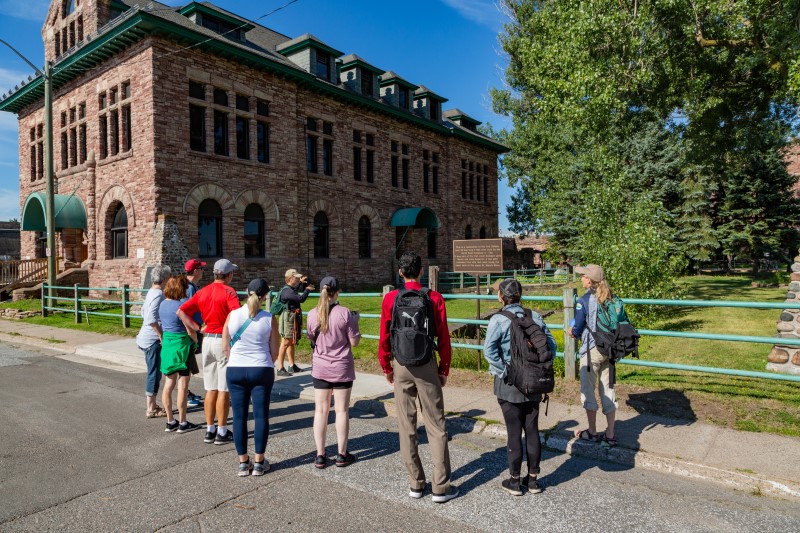
These interpretive tours provide visitors to Sault Ste. Marie with an exciting new way to discover the city, while making meaningful connections to the Soo’s vibrant Indigenous culture and heritage. Historic images, maps and hands-on materials add texture and context, transforming a modern cityscape into an historic gathering place, and an industrialized urban waterfront into a richly interconnected ecosystem.
For generations, the land that is now downtown Sault Ste. Marie was home to a thriving Métis community. The community was organized into river-lots that gave each family access to the river for travel, harvesting and economic activity. Families kept their animals communally in the area behind their homes and harvested maple sugar in spring along the escarpment. In the mid 1850s, Métis families were displaced from their lands, breaking promises by the Crown agent that their lands would be protected. Despite this injustice, the community continues to call Sault Ste. Marie home.
By sharing Métis perspectives on reciprocity and sustainable practices, the interpretive tours also advance the Lake Superior Watershed Conservancy’s work to promote watershed awareness and greater environmental understanding.
“The Métis story inextricably connects culture with ecology,” says McGuffin. “Indigenous people have been able to live with the land and care for our water for thousands of years, because it’s been a reciprocal relationship.”
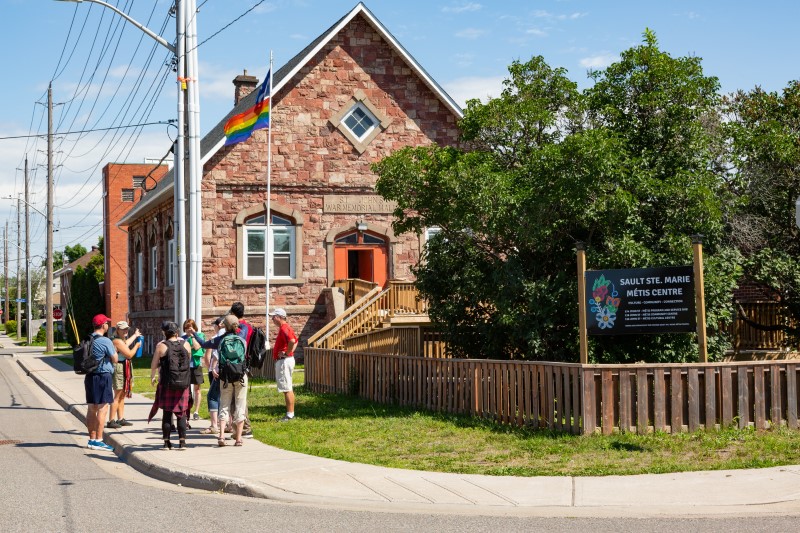
Tour participants can choose to join a Walking Tour or get on the water with a Walking & Paddling Tour. Both tours travel to the city’s scenic waterfront from the Sault Ste. Marie Métis Cultural Centre—a first of its kind in Ontario. Tours last two hours and are led by a Métis interpretive guide, giving visitors a fascinating glimpse into traditional and contemporary Métis life.
Paddling Tour participants board a Big Canoe—a replica of the 36-foot birch-bark canoes that once freighted furs and trade goods between Montreal and Lake Superior—to learn how the St. Marys River is central to both the story of Sault Ste. Marie, and the Indigenous communities who live here.
McGuffin believes passionately in the power of the Big Canoe to bring people together to share ideas and cultural understanding. In 2019, the Conservancy founded a new program called Canoes for Conservation, and she points to the Big Canoe’s stability, inclusivity and accessibility for non-paddlers and multi-generational groups of all ages.
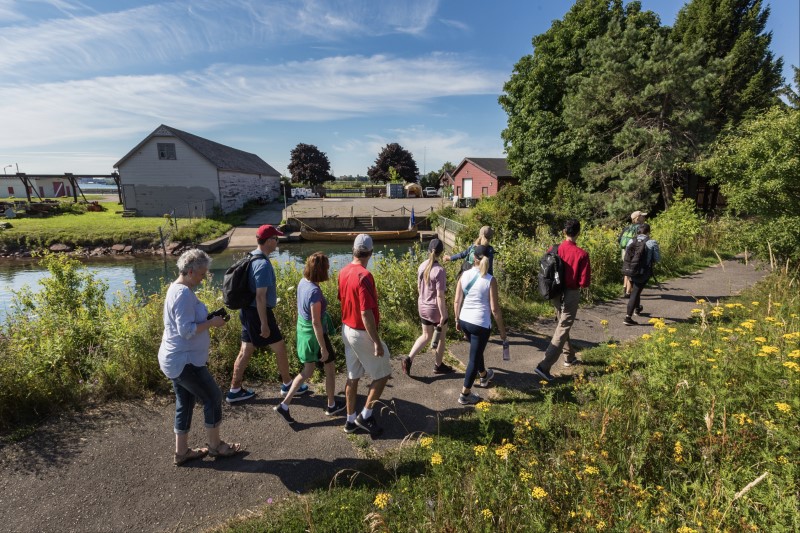
A highlight of the hour-long canoe portion of the journey is “locking through” the historic Sault Canal. Paddlers then venture onto the mighty St. Marys River—comparable in size and power to the Niagara River—feeling the spray of the rapids and the tug of the current beneath their hull. “It’s very tactile,” says McGuffin, “you have a paddle in your hands, you’re able to feel the water, listen to the water. It’s incredible how far into the rapids you can go—people are amazed by the experience.”
For the Métis Nation of Ontario, the tours are “an outstanding opportunity to grow Indigenous tourism in the north and advance reconciliation,” says community leader, historian and MNO Huron-Superior Regional Councillor, Mitch Case.
“In order to have that reconciliation conversation, Canadians need to understand who we are and what matters to us as a community,” he continues. By connecting across cultures, “we are protecting and preserving our unique heritage and world view.”
Lauren Towell is one of five young Métis community members who joined the interpretive guide team this summer. “The connections I share with the water resonate profoundly with the very fabric of my Métis heritage,” she says. “I take great pride in the task of sharing our story, ensuring that it endures for generations to come.”
Walking tour guide, Jake Chalmers, agrees, “Caring for our forests and wildlife is integral to caring for our Métis culture. Being a tour guide helps me to celebrate and share knowledge about both.”
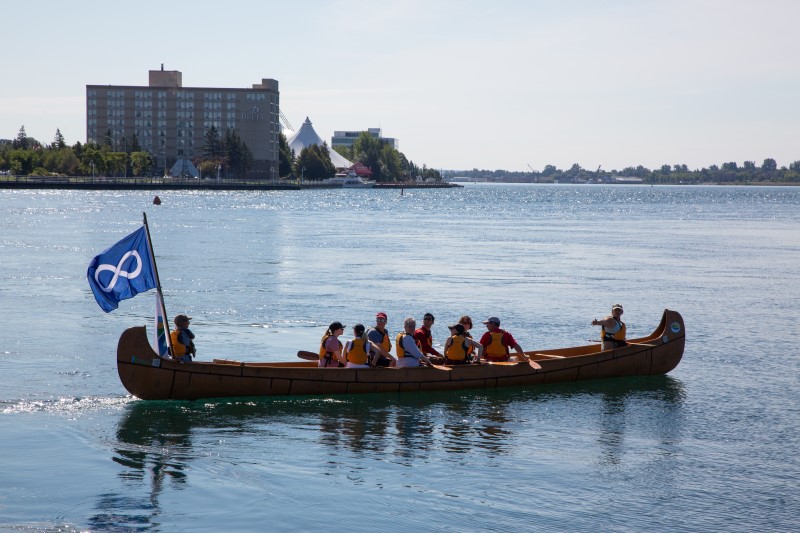
The tours visit numerous sites of great importance to the Métis community. In just a couple short hours, participants come to understand how connection to the river and love for their ancestors empowers the Métis community here—and what it can teach all of us.
For those visiting the city for the first time, the interpretive tours are also a great way to discover the Soo’s top scenic and cultural attractions.
As we stroll towards the river and the leafy promenades of Parks Canada’s Sault Ste. Marie Canal National Historic Site, McGuffin and I pass the Agawa Canyon Tour Train Station and Algoma Conservatory of Music. Housed in a refurbished, century-old sandstone building of the former St. Marys Paper Mill, The Loft is reported to have acoustics rivaling Massey Hall.
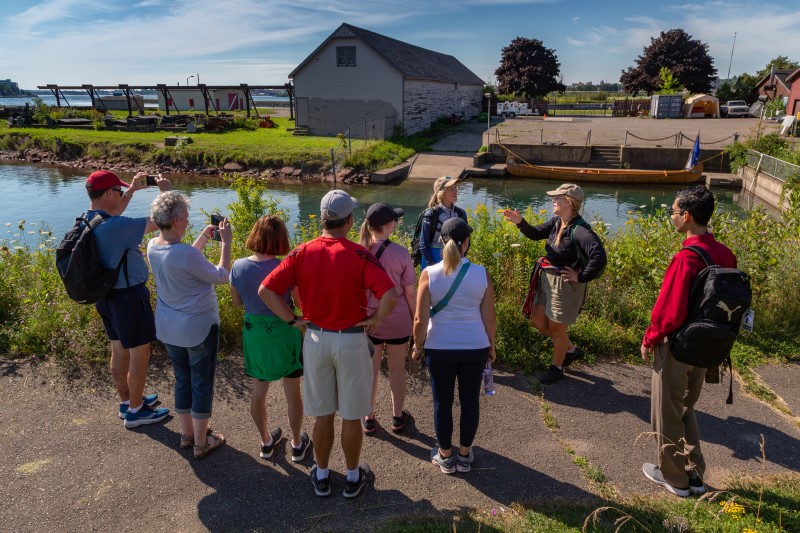
Outside, we see a re-creation of the rudimentary locks the voyageurs used to shuttle their Big Canoes around the Whitefish Rapids. Nearby, the weekly Mill Market hosts local food vendors and artisans where a Hudson’s Bay Company Post once stood.
As we walk, McGuffin tells me about the hidden river, where Fort Creek flows unseen beneath the city. She relates how downtown Sault Ste. Marie, from Bay Street to the river, is built entirely on reclaimed shoreline. “It’s not just about what we can see, it’s also what we can’t see,” she says. “When we don’t look at where water comes from and where it goes, we feel no responsibility for what happens along its journey.”
Before returning to the Métis Cultural Centre, we pause at the mouth of Fort Creek, marveling at the resilience and tenacity of water. The story of a people can be like a river that way—sometimes unseen, but always flowing steady and strong.
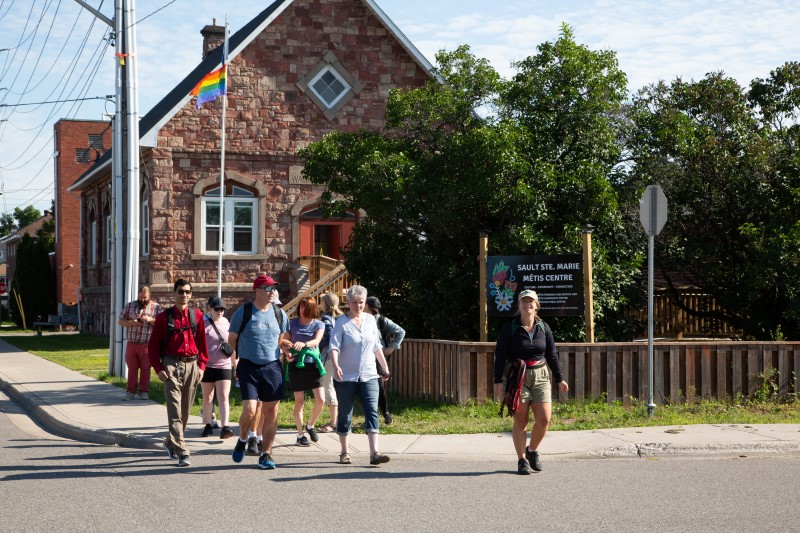
Guided Walking
Friday and Saturday mornings at 10:30 a.m.
Available late June–late September
Tours are 2 hours/5 km in duration
Cost is $50/adult or $25/student, group rate (max. 10 people) $350
Guided Walking & Paddling Tour
Thursday, Friday and Saturday evenings at 5 p.m.
Available late June–late September
Tours are 2 hours/7 km in duration
Cost is $90/adult or $45/student, group rate (max. 12 people) $675
All paddling safety equipment is included
Online Reservations
Individual and group reservations available. Learn more and book your tour now at Métis Tours.
Celebrate the 20th anniversary of the Supreme Court decision acknowledging the Metis Nation as a distinct Indigenous culture in Canada with a visit to the newly opened Métis Cultural Centre at 136 John Street.
Forest The Canoe are offering a variety of guided tours to see some of the best fall colours in Ontario. The True North Adventure Bus has full day, morning and evening guided tours running in September and October.
Witness the stunning fall colours you’ve seen on Instagram. Paddle beautiful inland lakes. Hike up the iconic Robertson Cliffs to witness a stunning vista of autumn colours that stretch as far as Lake Superior.
Contact experienced tour guides Forest The Canoe to see some of the most beautiful fall colours in Ontario. Ride the True North Adventure Bus this fall, with daily tours departing from Sault Ste. Marie.
Four fall colour tours are offered on the True North Adventure Bus, each a truly unique adventure, and a each chance to see and explore a different part of Northern Ontario. Tours last a full day, a morning or an evening with pick ups from local hotels in Sault Ste. Marie throughout the day.
Friends of Fall Colours
Explore the autumn colour change by water and land. Tours run 9.30am – 6.30pm.
Sunday, Sept 18th,
Friday, Sept 23rd,
Saturday, Sept 24th,
Sunday, Sept 25th,
Saturday, Oct 1st,
Sunday, Oct 2nd,
Wednesday, Oct 5th,
Friday, Oct 7th,
Friends of Fall Colours: Lite Edition
A micro version of Friends of Fall Colours. Tours run 4.30pm – 9.30pm
Wednesday, Sept 21st
Monday, Oct 3rd
Chase The Train
Chase the train all the way to Searchmont, then explore a beautiful waterfall on the Goulais River. Tours run 8am – 12.30pm.
Thursday, Sept 22nd
Monday, Oct 3rd
Tuesday, Oct 4th
Thursday, Oct 6th
Coastal Fall Colours at Sunset
Experience breathtaking views of Algoma Highlands along the greatest lake all the way to Montreal River. Tours run 5pm – 9.30pm
Thursday, Sept 22nd,
Monday, Sept 26th, Thursday, Sept 29th
Tuesday, Oct 4th,
Thursday, Oct 6th,
Sit back and enjoy the drive, that’s all you’ll have to do with the True North Adventure Bus. Expert, certified tour guides Ryan and Shana provide informative narration to help you get the most of your experience. Enjoy your day with all the quality equipment and safety information you will need.
By Diana Lee @only1phoenixx
Many of us that enjoy spending time in nature love learning more about the spaces we play in. Whether it’s learning about new paddling spots to launch from or about the wildlife we’ll see along the way, we outdoor enthusiasts typically want to get more out of our adventures!
When you go on an Indigenous-guided tour, be prepared to see, explore, and appreciate the lands and waters we play in from a different lens by recognizing and supporting Indigenous People’s deep connections with these spaces.
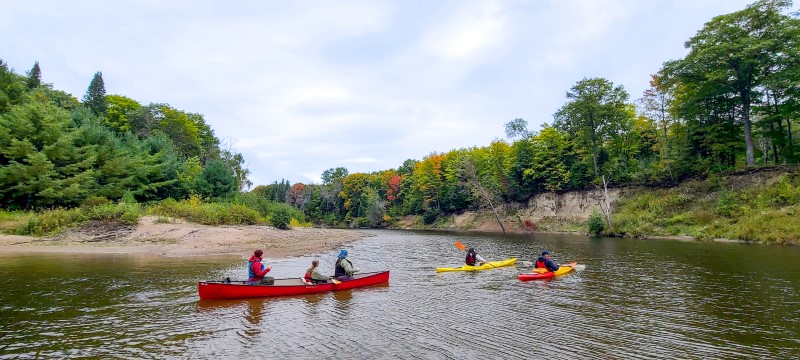
On a recent trip to Sault Ste. Marie in Algoma Country, home of the Anishinaabe since time immemorial, I spent some time with Thrive Tours, an Indigenous-owned and operated guided ecotourism company, and the experience went above and beyond a paddling tour.
As a non-Indigenous person, I’m always excited to learn more about our amazing province, country, and world. I’ve been lucky enough to join in on a few Indigenous travel adventures from Inuvik, Northwest Territories, to Puvirnituq, Quebec, and I’m happy to share a few highlights from my paddling trip and why you should plan your next adventure with an Indigenous-led tourism operator.
Whether you’re visiting Sault Ste. Marie (traditionally known as Baawaating), or a local, it’s always fun discovering new paddling spots in and around the city. As a stand-up paddleboarding (SUP) aficionado, I bring my paddleboard on all my road trips and travels. I was excited to learn I could BYO (bring your own) SUP for this Thrive Tours paddling adventure!
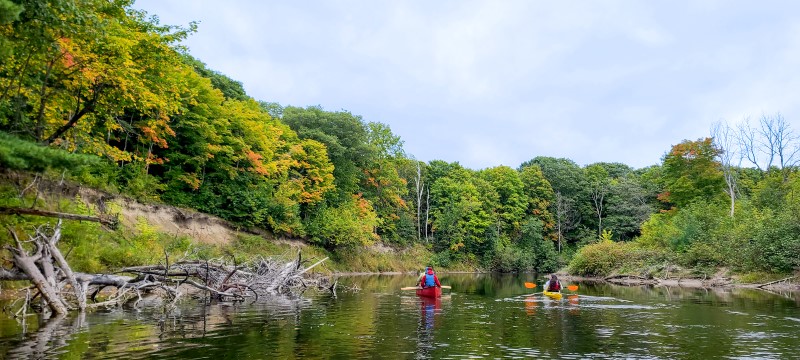
Our first stop was at Thrive Tours’ home base in the Soo, where I met the owners and operators, Amanda (Biimskoonkwaat) and Brad (Ozhaawashkwaa Animikii). Together, they adventure all year round, offering guided canoe, kayak, hiking, and snowshoeing while promoting and maintaining local Indigenous practices and philosophies.
After chatting about what we felt like doing – canoeing, kayaking, or stand-up paddleboarding (SUP), we packed up everything (yes, everything, haha!) We headed to Garden River, located in Garden River First Nation. I learned that this is a sacred area, and a guided tour is a great way to experience this waterway.
Before launching our boats and board, we began by offering Tobacco to the water, a sacred way to connect with all living things. Brad shared the importance of Semah, the Anishinaabemowin word for Tobacco, “when we place Tobacco in our left hand, it symbolizes the closeness of that medicine to our heart. When we transfer those good thoughts and meaningful intentions into the Semah and place it in the water, we connect with all our ancestors and creation itself.”
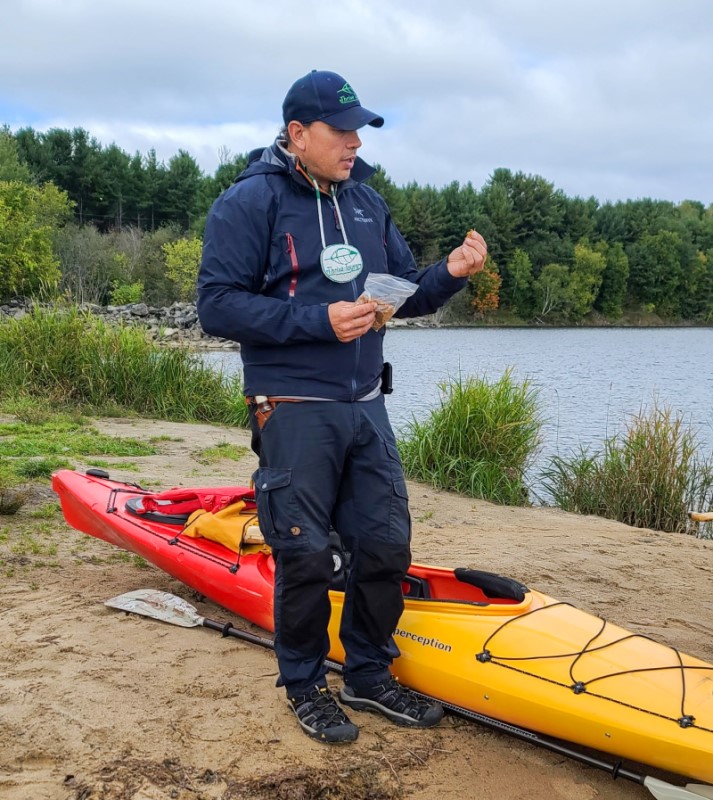
Seeing wildlife always sparks joy and the Thrive Tours team combined the sightings with Anishinaabe teachings right on the water. Seeing eagles, migizi in Anishinaabemowin, swooping down from the trees in front of us was incredibly special. Eagles also symbolize love, or zaagi’idiwin, as part of the 7 Grandfather teachings.
As we continued to paddle, the occasional splash of salmons jumping out of the water kept me excited about what we would see (and learn about) around the next bend of the meandering river.
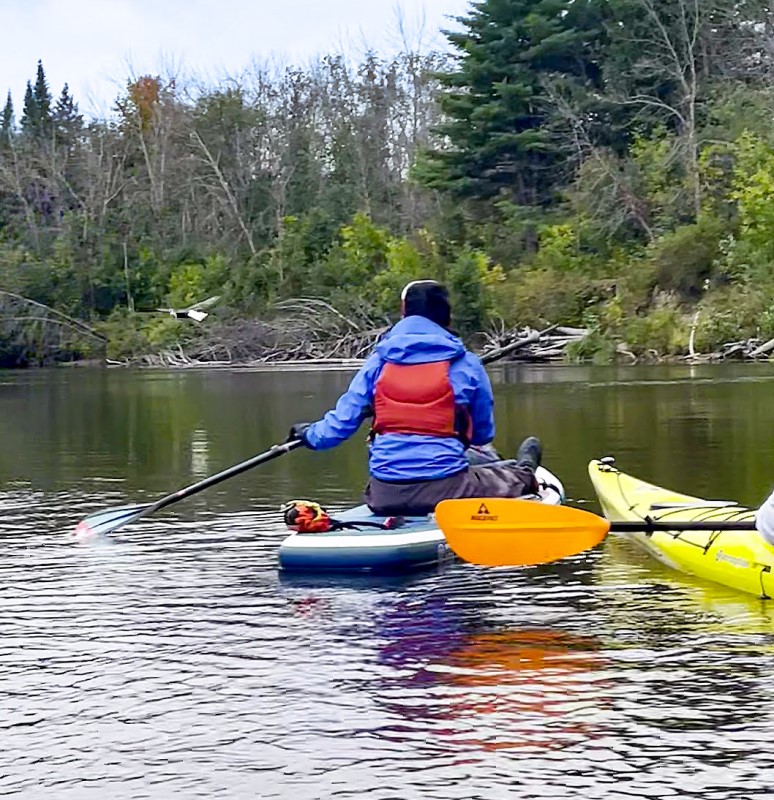
When it was time to take a break, we enjoyed warming up by a mini campfire, with snacks and great conversations while sipping warm Cedar Tea.
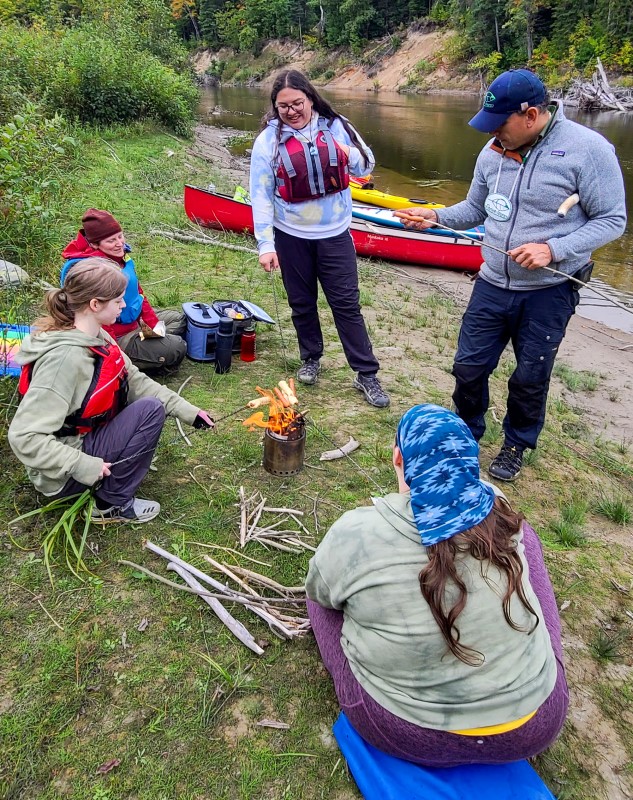
During this tour, I got to chat with Lucia Laford, a local Indigenous artist, educator and one of the Thrive Tour guides. Lucia leads a Paddle & Paint Woodland-style painting workshop where participants can create their own nature-inspired painting while out in nature! Lucia also teaches Anishinaabe Art and Material Practices at Algoma University.
“Woodland style is about visualizing the connection and relationships between people, animals, spirits, and nature. I paint my way of life, the Anishinaabe way, which includes ceremony and spirituality, but also my connection to the land and the plant, tree, and animal nations. In this way, my work is completely inspired by nature and the love and respect I feel towards Aki (the earth), Nibi (the water) and all things in creation.
The Paint & Paddle workshop is about connecting with yourself on the water and the land. Woodland art helps deepen that connection by exploring the relationships and personal kinship we have to life around us. We [Thrive Tours] helps facilitate the joy of being on the land and water, and we do so in a safe, respectful, and sustainable way. When paddling, we talk about the concepts in Woodland-style art while sharing Indigenous perspectives and teachings. Paddling and being able to touch the water and land that we are talking about serves as an incredible inspiration when painting!”
– Lucia Laford, Thrive Tour Guide, Woodland style painter and Indigenous Arts educator
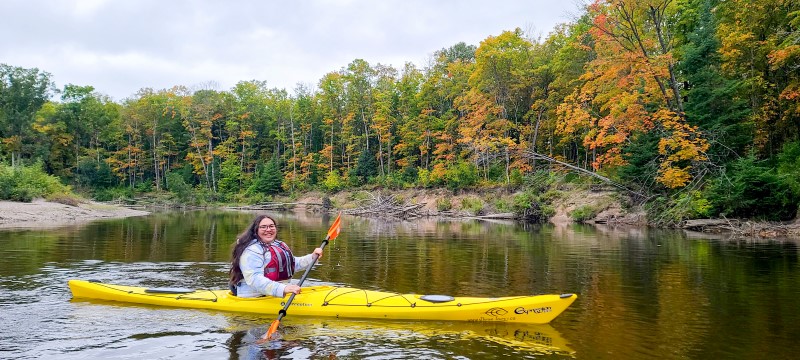
For many Indigenous People, music was a way of storing ecological, ancestral, and traditional knowledge and teachings. Passing along that knowledge was often done through stories and songs.
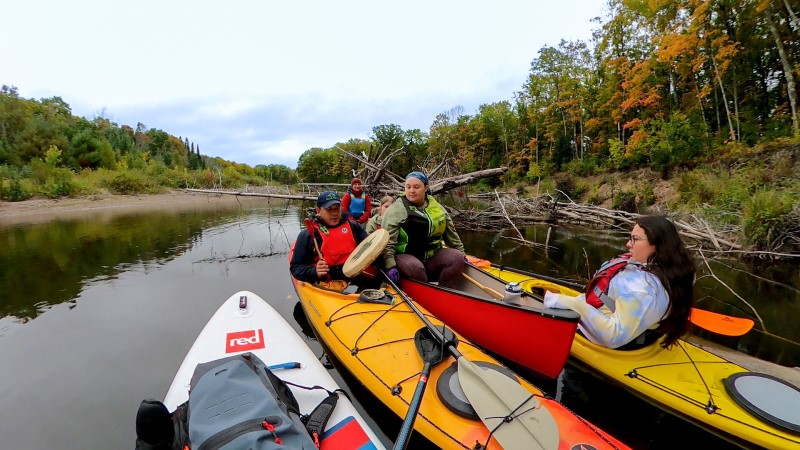
The gentle current carried us along the river while Amanda and Brad, a powwow singer and member of the Black Bull Moose Singers, shared a few honour songs for women and all of creation. Lucia also shared a Water Song*. The lyrics and varied tempo beautifully represent and honour water – from fast-moving rapids to the steady slow flow of a river, like the Garden River we were floating along. We were all invited to sing along and celebrate being on the water.
While I had no expectations for the tour and was open to going with the flow of Thrive Tours, the way we concluded our paddling adventure was incredibly moving. When I asked if they do this for every tour, Amanda explained, “while every experience [with Thrive Tours] unfolds uniquely, we consistently incorporate physical, emotional, mental, and spiritual aspects. Every adventure includes cultural teachings, Indigenous food sharing, nature-based activities, and First Nations ceremonies.”
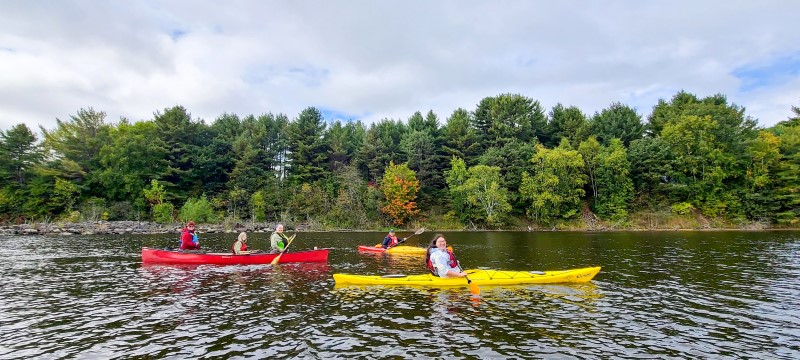
Authentic Indigenous-led travel experiences can help share the stories, histories, and perspectives we don’t get to hear more often. What we can do as allies is to help support that by taking these tours and being open to learning. These excursions that combine outdoor recreation with learning education alongside an Indigenous guide lead to more consideration, respectful, responsible, and meaningful future adventures, whether we travel solo or with company. Travel experiences like this are a step towards taking us beyond land acknowledgements through active participation and ongoing learning, all while adventuring in the spirit and continuous practice of reconciliation.
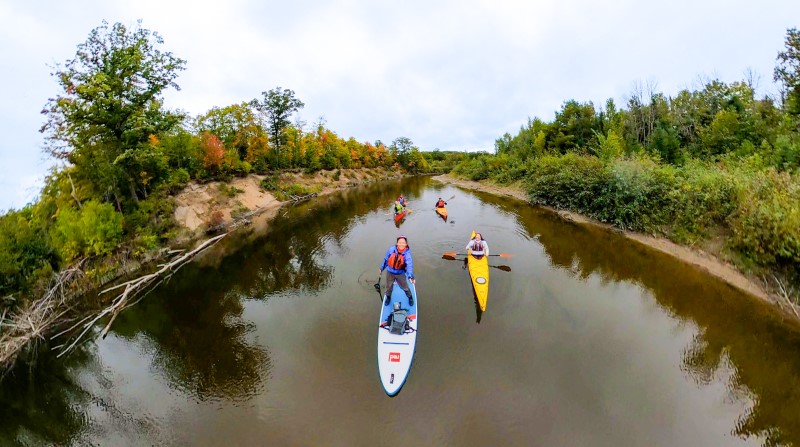
Thank you, Amanda, Brad, and Lucia, for the unforgettable time in Sault Ste. Marie. I look forward to seeing you again soon (hopefully in winter, my favourite season!)
Thrive Tours
https://www.thrivetours.ca/about
For more Indigenous-owned or led travel and adventure ideas:
Recommended resources and further reading:
Diana Lee lives for adventure, the great outdoors, and stand-up paddleboarding (SUP)! She is a certified ISA SUP Instructor, a librarian, and a reporter for Get Out There Magazine. Find out what she’SUP to @only1phoenixx on Instagram and Twitter.
By Conor Mihell
It’s no surprise that a community located in the heart of the Great Lakes would embrace all forms of paddlesports. Not only is Sault Ste. Marie the gateway city for some of the best coastal sea kayaking and wilderness canoeing in Canada, it also boasts amazing options for paddling minutes from downtown. Regardless if you’re passionate about standup paddleboarding, canoe tripping, sea kayaking, whitewater or recreational kayaking, there’s something for you in Sault Ste. Marie.
The Sault College Waterfront Adventure Centre is a community hub on the shore of the St. Marys River. Not only does the gorgeous facility feature a cafe with amazing views, the Waterfront Adventure Centre rents canoes, kayaks and standup paddleboards to explore the historic waterway that has always been central to Sault Ste. Marie’s raison d’etre. Evening is the best time of day for a paddleboard tour on the St. Marys River. Head east (downstream), past the Pine Street Marina, hugging the shore to appreciate the wildlife-rich wetlands of Bellevue Park, watching for ducks, mink and beaver. Rounding the isthmus of Topsail Island provides a new perspective on the city’s most popular park. If you time it right you’ll be graced with a spectacular sunset over the International Bridge on your way back.
Thrive Tours, a local Indigenous nature-based tour operator, offers guided canoe trips from the Waterfront Adventure Centre. These beginner-friendly outings share the full story of how the St. Marys River has supported life since time immemorial.
A downriver trip on the Goulais River, located just north of Sault Ste. Marie, is a springtime rite of passage for whitewater paddlers. This section of river requires high water, and the section from Mountainview Lodge on Highway 556 to the Highway 552 bridge can be done in as little as 4 hours thanks to a steady current. It’s best to make it a day trip to enjoy the Goulais’s soaring, pine-clad hills and great wildlife, including moose, waterfowl and beaver. This section includes Class I and II rapids, as well as plenty of swift water, making it suitable for novice whitewater paddlers–just make sure you travel with companions and dress for cold water temperatures. Stay at the nearby Bellevue Valley Lodge and pack a lunch to enjoy on one of the Goulais’s many gravel bars. As water levels decrease in late May and early June this section is great for anglers, with abundant walleye and smallmouth bass, as well as the possibility of rainbow- and brook trout.
Forest the Canoe offer guided nature tours on the lakes and rivers in the area, as well as on Lake Superior.
You won’t find a more remote–and picture perfect–retreat than Norm’s Cabin, tucked away in the Precambrian hills of the Algoma Highlands, north of Sault Ste. Marie. This off-grid cabin is located in Goulais River, a half-hour drive north of Sault Ste. Marie, and is accessible only by food or mountain bike. Rental comes with access to a canoe, and the freedom to explore gem-like lakes atop the rooftop of Ontario. Norm’s is popular for couples, families and getaways with friends. Contact Blaq Bear Eco Adventure Routes to plan your stay.
The hamlet of Gros Cap at the end of Highway 550, only 20 minutes west of Sault Ste. Marie, marks the eastern terminus of Lake Superior. An official launch on the Lake Superior Water Trail (a segment of the Trans Canada Trail) includes an accessibility dock, outhouses, picnic area and kayak storage locker. Paddling west provides an immediate glimpse of Lake Superior’s rugged shoreline: you’ll encounter spectacular cliffs, gravel beaches and a vast, open horizon along the 10-km section to Red Rock. Be sure to check the weather conditions in advance; this exposed stretch of shoreline is suitable for experienced paddlers only, with sea kayaks, sprayskirts and safety gear to mitigate the risk of cold water.
Central Algoma is a bucolic landscape of maple, oak and pine forests and small inland lakes, just east of Sault Ste. Marie. There are several public parks accessible via Highway 638, a quiet secondary route between Echo Bay and Bruce Mines, with great options for canoeing and recreational kayaking on calm and sheltered water. Visit Old Mill Beach Park on Rock Lake to discover a family-friendly waterfront for swimming and quiet paddling at the mouth of the meandering Thessalon River; this area is especially attractive to birders and naturalists, with a wide variety of song- and shorebirds and aquatic mammals. The Central Algoma Freshwater Coalition has produced an adventure map highlighting paddling and other outdoor activities throughout the region.
It’s amazing to discover a quiet, scenic, wilderness canoe route on Crown land barely 30 minutes from downtown Sault Ste. Marie. The Jarvis Circle Route is a perfect long-weekend getaway for novice and intermediate paddlers. The journey begins at a small public launch on Northland Lake, located off of Highway 556. A series of rugged portages (watch for discrete yellow signs to mark most) links nearly a dozen secluded lakes with many options for primitive camping, including Jarvis, Reserve and Crooked lakes—all of which boast excellent fishing for trout. This is a great area to practice your canoe tripping skills and get a taste of the wilderness of Northern Ontario.
For more information about paddling in Sault Ste. Marie, visit our Watersport page. For information about paddling in Algoma Country click here!
By Conor Mihell
With water all around, Sault Ste. Marie is one of the best places in Ontario to go paddling. The city is located in the heart of the Great Lakes, with pristine freshwater coastlines, wilderness lakes and rivers located within easy access. Great Lakes Superior and Huron offer some of the best sea kayaking in the world; the St. Marys River is a scenic and historic waterway flowing right through downtown; and Lake Superior Provincial Park offers excellent canoe tripping, backcountry angling opportunities and rugged Canadian Shield scenery. Whether you love sea kayaking, canoeing or standup paddle boarding, Sault Ste. Marie is an amazing destination for an Ontario paddling trip.
The Lake Superior Watershed Conservancy and the Metis Community offer big canoe experiences on the St Mary’s River in downtown Sault Ste Marie. No previous experience is necessary to participate in our safe and stable 36-foot canoe led by 2 trained canoe guides. Metis guides sharing stories of the culture and wildlife is enjoyable for participants of all ages and most abilities. For multi-generational families, co-workers, and friends looking for a fun time together. Make memories paddling on this historic waterway linking Lake Superior with the lower Great Lakes. Tours are 2 hours and group bookings available
Based just north of Sault Ste. Marie in Goulais River, Forest The Canoe provides guided interpretive in Lake Superior Provincial Park. This brand-new outfitter focuses on small-group tours that reveal the wonders of nature in Northern Ontario. You don’t have to be a veteran paddler to participate. Forest The Canoe provides inclusive wilderness programs for families and beginners, as well as rentals and logistical support for more experienced paddlers.
Naturally Superior Adventures in Wawa has offered guided sea kayak trips and certified instruction since 1994. The company specializes in Lake Superior sea kayak trips for all experience levels. Multi-day wilderness tours are offered in Lake Superior Provincial Park and Pukaskwa National Park—world-class sea kayak destinations located within a short drive of Sault Ste. Marie. The company also offers accommodations on Lake Superior, vehicle shuttles and canoe, kayak and paddleboard rentals.
Indigenous owned and operated Thrive Tours Thrive Tours offers land-based experiences in the Sault Ste. Marie region that are designed to connect people with each other and Mother Earth’s offerings with respect for the land, water, and all living things.
Looking for a quick paddling trip in Sault Ste. Marie? Check out the Sault College Waterfront Adventure Centre on the St. Marys River. You can rent a canoe, kayak or standup paddleboard to explore the shoreline and get a new perspective of the city. Enjoy a coffee and baked snack when you’re done on the waterfront patio.
Great Lakes Outfitters is a locally owned Sault Ste. Marie outdoor store that has recently invested in a fleet of canoes, sea kayaks and standup paddleboards. Experienced paddlers can rent gear and set off on their own adventure, near or far.
Bring your canoe or kayak down to this new public dock! Complete with accessible transfer system, this new feature to the Sault Ste. Marie waterfront is located in Bellevue Marina and features user friendly technology suitable for all skill levels. The location is connected to a paved path leading from the car park for greater accessibility.
Standup paddleboards can use it too, just off to the side. Click on this link to view the facebook post, see more photos and join in the discussion!
Looking for a place to stay while visiting Sault Ste. Marie? Consider visiting Kayak.com for an UpToDate list. Click here for more info.
By Conor Mihell
Put these routes on your canoeing bucket list
From half-day jaunts to wilderness expeditions, these rivers offer the very best canoeing, fishing, and rapids in Ontario.
Ontario has some of the best river canoe trips in the world. I’m especially fond of the wild rivers in Northern Ontario. As an avid backcountry canoeist, I sometimes worry that my bucket list may exceed my longevity. Here is a collection of eleven of my personal favourites in Northern Ontario.
Click here to read more…
By Peter Greve
Take a canoe trip along the St. Marys River in Sault Ste. Marie
Water runs through us, around us, and in our homes. Love water. Respect water. Take care of it. Experience all this and more on the St. Marys River, a great place to go canoeing in Northern Ontario.
Water
We are freshwater people. People of gaaming and people of ziibi. Water runs through us, around us, and in our homes. Water breaks before we enter the world. The Anishinaabe (original people) have many words for nibi, because it can mean many things to life.
In English, we have one word for water. Freshwater is sacred. It is something worth protecting. When the McGuffins, a charismatic, conservation-oriented canoeing couple, travelled the thousands of kilometres of Lake Superior shoreline, they also carried an important message: Love water. Respect water. Take care of it.
Click here to read more…